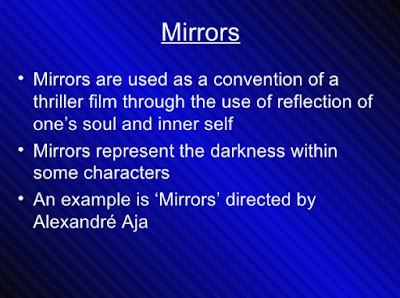What is iconography?
It is anything that conventionally and symbolically represents the genre. These can be things such as objects, locations of certain images. To be iconic the certain 'thing' must be easily recognisable and associative with the genre.
Why is iconography so important?
It is important as a lot of iconography has to do with the mise-en-scene. The physical attributions in a scene of a film in general give a lot of obvious indications to the audience and helps construct the plot line and elevates the feelings that were meant to make the audience feel a certain way when watching a thriller film.
This can include mirrors, low key lighting, shadows, obtrusive editing, quick cuts, changes in camera angles, tension music, stairs, flashbacks, use of photographs, black and white, disorientation of time and space, montage editing. Specific to psychological thrillers: Two or more characters preying upon one another's minds, deceptive mind games, trying to demolish each others mental state.
- Having the blockade of freedom for a character creates the sense of imprisonment and entrapment, not just for the character but for the audience also.
- The audience becomes engaged with the character in regards to sympathy and experience the same mirrored feelings of sympathy. Feeling as though you are going through the same experience as the character as an audience member, especially in a thriller is particularly effective as the tense atmosphere created goes hand in-hand with the genre by playing on the fear of being isolated.
One flew over the Cuckoo's Nest (Milos Foreman, 1975.)
Confined Spaces.
- A confined space is definitely an icon within the genre of thrillers. Thriller films make the audience nervous and a way to do this is by playing on the demographics fears. 3% of the population are claustrophobic, therefore using this as a way to terrorise the audience is particularly effective.
Running water.
- Another iconic thing that is commonly included in thriller films is running water. Running water can represent the draining of life and can keep the audience on edge as to use something as ordinary as running water within an environment where it is made sinister breaks the boundary of comfort for the audience. Running water is particularly used for jump scares as audiences least expect them.
Shadows.
- Shadows give psychological thrillers the 'on edge' tense feeling by using something with such anonymity. It is commonly associated with thrillers as they generally build up the fear in the demographic.
- In many cases, the protagonist is usually unaware of shadows and they become something that passes by unnoticed by everyone but the audience. The character may be about to encounter a situation that is quite dangerous that they are not aware of the situation, creating dramatic irony.
Street Lamps
- Street lamps are an effective part in mise-en-scene and are effectively used in thriller films particularly in relation to the protagonist.
- This is because the light directly shines on the character, acting almost as a spotlight, and the surrounding being mainly in the darkness.
- This can be iconic as the surrounding dark can represent the struggles of the protagonist. Furthermore, the fact that there is plainly a spotlight on the protagonist could show isolation. This is effective for the audience as it could engage them too, making them also feel alone as there isn't much else more on screen to focus on as a safety barrier.










No comments:
Post a Comment